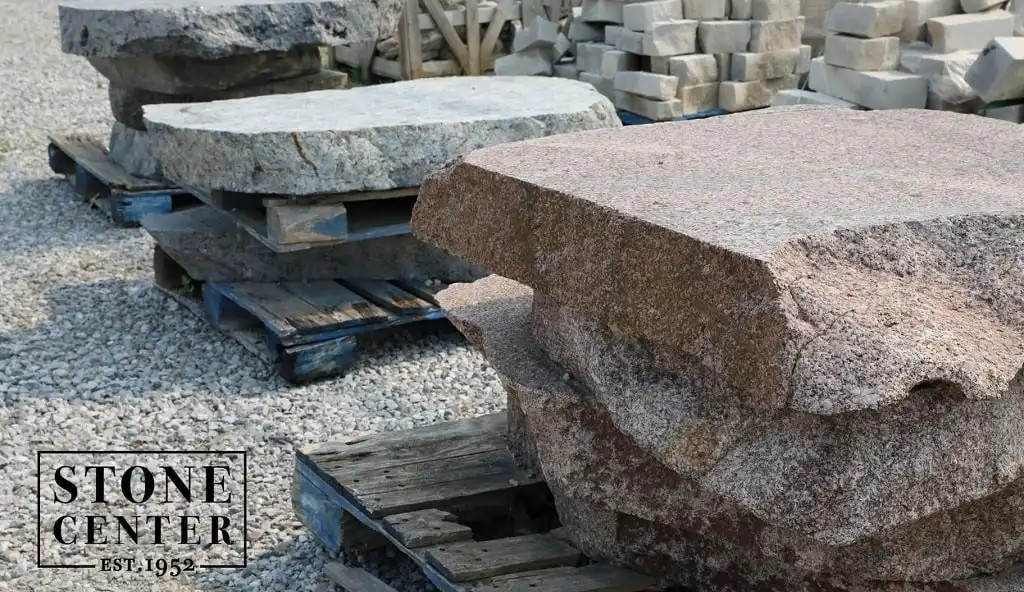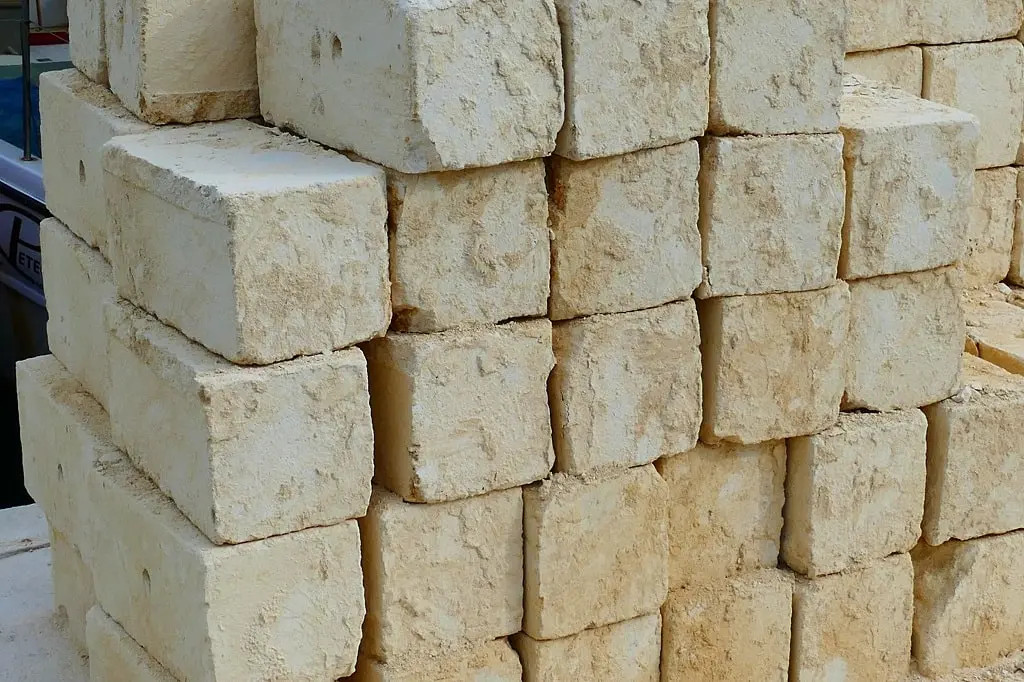Granite rock is a fascinating and versatile natural stone, and understanding its appearance is key to appreciating its many uses in landscaping and construction. At rockscapes.net, we’re dedicated to providing you with all the information you need to choose the perfect stone for your project, transforming your outdoor spaces into stunning rockscapes. Explore the unique characteristics of granite, from its coarse-grained texture to its varied color palette, and discover how this durable stone can enhance your environment.
1. What Defines the Appearance of Granite Rock?
Granite rock is easily identifiable by its coarse-grained texture, a direct result of its formation deep within the Earth’s crust. This texture is characterized by interlocking crystals of minerals such as quartz, feldspar, and mica, which are large enough to be visible without magnification. The crystalline structure gives granite a speckled appearance, with individual mineral grains contributing to the overall aesthetic. This texture is one of the primary features that distinguishes granite from other types of stone, making it a popular choice for a variety of applications, from countertops to exterior cladding. The unique appearance of granite is not only visually appealing but also contributes to its durability, making it a preferred material for both residential and commercial projects.
 Granite rock with visible crystals
Granite rock with visible crystals
2. What Colors and Patterns Can Granite Rock Exhibit?
Granite rock displays a wide array of colors and patterns, largely dependent on its mineral composition. While commonly found in shades of gray, pink, and white, granite can also exhibit hues of red, blue, and even green. These colors arise from the presence of different minerals; for instance, the presence of potassium feldspar can lead to pink or reddish tones, while amphibole or biotite mica can contribute to darker, black shades. The patterns in granite are equally diverse, ranging from uniform speckling to swirling veins and dramatic bands. These patterns are often a result of the cooling process and the distribution of minerals within the rock. For homeowners and designers, this variety provides ample opportunities to select granite that complements their aesthetic preferences and architectural styles, ensuring that each project is unique.
3. How Does the Mineral Composition Influence Granite’s Look?
The mineral composition of granite rock significantly influences its overall appearance. As an igneous rock, granite primarily consists of quartz, feldspar, mica, and other trace minerals. Quartz typically appears as clear or glassy grains, contributing to the light-colored, speckled appearance of granite. Feldspar, which is usually the most abundant mineral in granite, can be either plagioclase or orthoclase, exhibiting colors ranging from white to pink to gray. Mica, present as either biotite or muscovite, adds dark, flaky inclusions that can create a shimmering effect. The specific proportions of these minerals, as well as the presence of other minerals like amphibole or hornblende, determine the unique color and pattern variations seen in different types of granite.
According to research from Arizona State University’s School of Earth and Space Exploration, the specific mineral composition not only affects the color and pattern but also influences the rock’s durability and resistance to weathering.
4. Where Can You Find Different Varieties of Granite?
Granite rock is found across the globe, with different regions yielding unique varieties based on their geological history. Brazil is renowned for its colorful granite featuring exotic patterns, while India is a major source of granite with consistent colors and textures. In North America, granite is commonly quarried in states like Vermont, New Hampshire, and Georgia, where it exhibits a range of colors from light gray to dark black. Each region’s granite reflects its local geological conditions, including the types of minerals present and the cooling rates of the molten rock. This geographical diversity ensures a wide selection of granite options for construction and landscaping projects. Rockscapes.net can help you source granite from various regions to meet your specific design needs.
 Granite rock in various colors
Granite rock in various colors
5. What Textural Variations Exist in Granite Rock?
Granite rock exhibits several textural variations that enhance its aesthetic appeal and suitability for diverse applications. The most common texture is phaneritic, characterized by easily visible crystals that give the rock a coarse-grained appearance. However, variations in crystal size and arrangement can lead to different textural effects. For example, porphyritic granite contains large, prominent crystals (phenocrysts) embedded in a finer-grained matrix, creating a striking visual contrast. Additionally, granite can exhibit gneissic banding, a layered texture caused by the alignment of minerals under intense pressure during metamorphism. These textural variations not only influence the appearance of granite but also affect its physical properties, such as strength and resistance to weathering.
6. How Does Polishing Affect the Appearance of Granite?
Polishing granite rock significantly enhances its appearance by bringing out the natural colors and patterns of the stone. The polishing process involves using a series of abrasive pads to smooth the surface, gradually refining it to a high gloss. This not only creates a reflective sheen but also accentuates the crystalline structure and mineral inclusions within the granite. Polished granite is particularly popular for countertops, flooring, and decorative elements, as the smooth, reflective surface is easy to clean and maintain. However, it’s important to note that polishing can also make the granite more susceptible to scratches and etching from acidic substances.
7. What Are Common Applications of Granite Based on Its Appearance?
Granite rock’s aesthetic qualities make it a versatile material for a wide range of applications. Its durability and resistance to weathering make it an excellent choice for exterior uses such as building cladding, paving stones, and landscaping features. The variety of colors and patterns available in granite allows architects and designers to select stones that complement different architectural styles and design themes. Inside, polished granite is commonly used for countertops, flooring, and wall cladding, adding a touch of elegance and sophistication to interior spaces. The unique appearance of granite, combined with its practical properties, makes it a popular choice for both residential and commercial projects.
8. How Does Granite Compare to Other Natural Stones in Appearance?
Granite rock differs significantly in appearance from other natural stones such as marble, limestone, and slate. Unlike the fine-grained, uniform appearance of marble, granite exhibits a coarse-grained texture with visible crystals of various minerals. Limestone, a sedimentary rock, often features a more muted color palette and a softer, more porous surface compared to granite’s hard, crystalline structure. Slate, known for its distinct layered appearance and dark color, contrasts with granite’s speckled and varied color range. These differences in appearance reflect the different geological processes through which each stone is formed, making them suitable for different design applications.
9. Can Granite’s Appearance Vary Within a Single Slab?
Yes, granite rock can exhibit variations in appearance within a single slab, due to the natural processes that occur during its formation. These variations can include differences in color intensity, mineral distribution, and pattern density. For instance, a slab of granite might contain areas with more concentrated veining or sections with a higher proportion of a particular mineral, leading to localized color variations. These natural variations are part of granite’s appeal, as they ensure that each slab is unique and adds character to the finished product. However, it’s important for homeowners and designers to carefully inspect granite slabs before installation to ensure that any variations align with their design preferences.
10. How to Choose the Right Granite Based on Its Appearance for Your Project?
Choosing the right granite rock for your project involves considering several factors related to its appearance. First, evaluate the color palette of the granite and how it complements the overall design scheme of your space. Consider the patterns and veining present in the granite and whether they align with your aesthetic preferences. Also, think about the texture of the granite – whether you prefer a coarse-grained, heavily speckled appearance or a more uniform, subtly textured surface. Finally, assess the finish of the granite (polished, honed, or flamed) and how it enhances the stone’s appearance and functionality for your specific application. By carefully considering these factors, you can select granite that not only meets your practical needs but also elevates the visual appeal of your project.
Understanding Granite: A Deep Dive for Rockscapes Enthusiasts
Granite, a cornerstone of architectural and landscaping design, presents a unique blend of durability and aesthetic appeal. But what exactly contributes to its distinctive appearance, and how can you, as a discerning homeowner or designer, leverage these characteristics to enhance your projects? Let’s explore the key factors that define what a granite rock looks like, providing you with the knowledge to make informed decisions.
Granite’s Composition: The Foundation of Its Appearance
Granite’s appearance is intrinsically linked to its mineral composition. As an igneous rock, it’s primarily composed of quartz, feldspar, mica, and other trace minerals. The interplay of these components dictates the color, texture, and overall visual appeal of the stone.
- Quartz: Typically translucent or white, quartz contributes to granite’s hardness and light-reflecting properties. Its presence can create a sparkling effect, adding depth and dimension to the stone.
- Feldspar: This is the most abundant mineral in granite, and it comes in two primary forms: plagioclase (white to gray) and orthoclase (pink to reddish). The type and proportion of feldspar significantly influence the overall color of the granite.
- Mica: Biotite (black) and muscovite (silver-white) are the two main types of mica found in granite. They add dark, flaky inclusions that can create a shimmering effect or contribute to the stone’s overall pattern.
- Other Minerals: Small amounts of amphibole, hornblende, and other minerals can introduce additional colors and textures, further diversifying granite’s appearance.
Color Variations: A Spectrum of Possibilities
Granite’s color palette is incredibly diverse, ranging from classic blacks and grays to vibrant reds, blues, and greens. These variations are primarily determined by the types and proportions of feldspar and other minerals present in the stone.
- Gray Granite: This is the most common type of granite, characterized by a mix of white quartz, gray feldspar, and black mica.
- Pink Granite: The presence of potassium feldspar gives this granite a pink or reddish hue.
- Black Granite: While technically not true granite (it’s often gabbro or diabase), these dark-colored stones are commonly marketed as black granite and feature a high concentration of dark minerals like biotite and amphibole.
- Blue Granite: This rare and highly sought-after granite gets its blue color from the presence of labradorite or other iridescent minerals.
- Green Granite: Serpentine or other green minerals can impart a green hue to granite, creating a unique and eye-catching appearance.
Textural Characteristics: Coarse Grains and Crystalline Structures
One of the defining features of granite is its coarse-grained texture. This is due to the relatively slow cooling process that allows large crystals to form. The size and arrangement of these crystals contribute to the overall texture and visual appeal of the stone.
- Phaneritic Texture: This is the most common texture in granite, characterized by easily visible crystals of roughly equal size.
- Porphyritic Texture: Some granite contains large, prominent crystals (phenocrysts) embedded in a finer-grained matrix. This creates a striking visual contrast and adds depth to the stone.
- Gneissic Banding: Under intense pressure, the minerals in granite can align, creating a layered or banded appearance. This texture is more common in metamorphic rocks but can also occur in some types of granite.
Finishes: Enhancing Granite’s Natural Beauty
The finish applied to granite can significantly impact its appearance and suitability for different applications. Here are some of the most common finishes:
- Polished: This finish creates a high-gloss, reflective surface that accentuates the colors and patterns in the granite. It’s ideal for countertops, flooring, and other interior applications where a sleek, elegant look is desired.
- Honed: A honed finish provides a matte, non-reflective surface. It’s less slippery than polished granite and is a good choice for high-traffic areas or outdoor applications.
- Flamed: This finish involves exposing the granite to high heat, causing the surface crystals to burst and create a rough, textured surface. Flamed granite is often used for paving stones, steps, and other exterior features.
- Brushed: A brushed finish is achieved by using abrasive brushes to create a slightly textured, weathered look. It’s a good choice for adding character and warmth to granite surfaces.
Granite in Landscaping: Creating Stunning Rockscapes
Granite’s durability, versatility, and aesthetic appeal make it an excellent choice for a wide range of landscaping applications. Here are just a few ideas:
- Retaining Walls: Granite boulders and blocks can be used to create sturdy and visually appealing retaining walls.
- Pathways and Patios: Granite pavers and flagstones can be used to create elegant and durable pathways and patios.
- Water Features: Granite rocks and boulders can be incorporated into water features like fountains and waterfalls, adding a natural and dramatic touch.
- Rock Gardens: Granite is an ideal material for creating rock gardens, providing a stable and visually appealing backdrop for plants.
- Decorative Accents: Granite pebbles, gravel, and crushed stone can be used to add texture and color to garden beds, pathways, and other landscape features.
Sourcing Granite: Considerations for Your Project
When selecting granite for your project, it’s important to consider the following factors:
- Color and Pattern: Choose granite that complements the overall design scheme of your space.
- Texture: Select a texture that aligns with your aesthetic preferences and functional needs.
- Finish: Choose a finish that enhances the granite’s appearance and provides the desired level of slip resistance.
- Durability: Ensure that the granite is suitable for the intended application and can withstand the elements.
- Cost: Granite prices can vary widely depending on the type, color, and finish. Set a budget and shop around to find the best value.
By carefully considering these factors, you can select granite that not only meets your practical needs but also elevates the visual appeal of your project.
Why Choose Rockscapes.net for Your Granite Needs?
At rockscapes.net, we understand the importance of quality and selection when it comes to natural stone. We offer a wide range of granite options to suit any project, from small residential gardens to large-scale commercial developments. Our team of experts can help you choose the perfect granite for your needs, providing guidance on color, texture, finish, and installation.
We source our granite from reputable quarries around the world, ensuring that you receive the highest quality stone at a competitive price. We also offer a variety of value-added services, including custom cutting, finishing, and delivery.
Elevate Your Space with Granite from Rockscapes.net
Granite is a timeless and versatile material that can add beauty, durability, and value to any project. Whether you’re building a retaining wall, creating a patio, or designing a rock garden, granite is an excellent choice.
Visit rockscapes.net today to explore our wide selection of granite options and discover how we can help you transform your outdoor spaces into stunning rockscapes. Let our experts guide you in choosing the perfect granite to bring your vision to life.
Address: 1151 S Forest Ave, Tempe, AZ 85281, United States
Phone: +1 (480) 965-9011
Website: rockscapes.net
FAQ: Everything You Need to Know About Granite Rock
1. Is granite rock always gray?
No, granite rock comes in a wide range of colors, including gray, pink, red, blue, and green, depending on its mineral composition.
2. What makes granite rock so durable?
Granite rock’s durability comes from its dense, crystalline structure and the interlocking of its mineral grains.
3. Can granite rock be used in areas with harsh weather conditions?
Yes, granite rock is highly resistant to weathering, making it suitable for use in areas with extreme temperatures and moisture.
4. How does the finish affect the appearance of granite rock?
The finish can significantly change granite’s appearance, with polished finishes creating a glossy look and honed finishes offering a matte appearance.
5. What is the best way to clean granite rock surfaces?
Use a mild detergent and water to clean granite surfaces, avoiding harsh chemicals that can damage the stone.
6. Can granite rock be used for kitchen countertops?
Yes, granite is a popular choice for kitchen countertops due to its durability and resistance to heat and scratches.
7. How can I tell the difference between granite and other types of stone?
Granite is characterized by its coarse-grained texture and visible crystals, which distinguish it from finer-grained stones like marble and limestone.
8. What are some creative ways to use granite in landscaping?
Granite can be used for retaining walls, pathways, water features, and rock gardens, adding both beauty and functionality to outdoor spaces.
9. Does the appearance of granite rock vary from slab to slab?
Yes, due to natural variations in mineral composition, the appearance of granite can vary significantly between different slabs.
10. Where can I find high-quality granite rock for my project?
Visit rockscapes.net to explore a wide selection of granite options and receive expert guidance on choosing the perfect stone for your needs.
Remember to visit rockscapes.net for more inspiration, expert advice, and the highest quality granite to make your landscape dreams a reality. Discover the perfect granite to elevate your space today.
